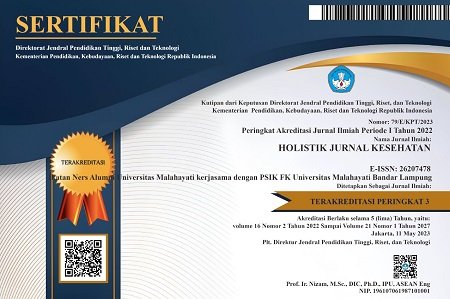Perilaku pencegahan konstipasi pada lansia di panti sosial rehabilitasi lanjut usia
Abstract
Background: Constipation in the elderly occurs because of physiological changes in the body that are also supported by poor health behavior. The reduced risk of constipation when the elderly apply healthy lifestyle modifications.
Purpose: To describe the constipation occurrence among the elderly living in long-stay institutions in Ciparay Bandung
Method: A descriptive quantitative that involved 38 elderly, selected by purposive sampling technique with inclusion criteria, which are communicative elderly, have a good cognitive condition (MMSE score 23-30). The instrument used a questionnaire sheet and data analysis used univariate frequency distribution.
Results: The finding of 57.9% of respondents had good prevention of constipation. The percentage in each sub-variable shows that 55.3% of respondents had good physical activity, 50% of respondents had good dietary habits, and 57.9% of respondents had good defecation habits.
Conclusion: The results of the study show that over 50% of the elderly are still under the control of constipation problems. Suggestions for the management of long-stay institutions in Ciparay Bandung, to continue observation risk constipation and prevent to provide information and motivation promotion especially in physical activity and eating habits with Group Activity Therapy.
Keywords: Constipation; Elderly; Physical activity; Eating habits; Lifestyle
Pendahuluan: Konstipasi pada lansia terjadi karena adanya perubahan fisiologis tubuh yang juga didukung oleh perilaku kesehatan yang kurang baik. Konstipasi dapat dicegah jika lansia melakukan modifikasi gaya hidup sehat.
Tujuan: Untuk mengetahui gambaran perilaku pencegahan konstipasi pada lansia di Panti Sosial Rehabilitasi Lanjut Usia dan Pemeliharaan Makam Pahlawan (PSRLU-PMP) Ciparay Bandung.
Metode: Penelitian deskriptif kuantitatif dengan melibatkan 38 lansia yang dipilih menggunakan teknik purposive sampling dengan kriteria inklusi, yaitu lansia yang komunikatif, memiliki kondisi kognitif yang baik (skor MMSE 23-30), dan bersedia menjadi responden penelitian. Instrumen yang digunakan berupa lembar kuesioner yang dibuat berdasarkan hasil penelitian dan telah dilakukan uji validitas dan reliabilitas. Analisis data yang digunakan berupa perhitungan distribusi frekuensi.
Hasil: Sebanyak 57,9% responden memiliki perilaku pencegahan konstipasi yang baik. Adapun persentase pada setiap sub variabel menunjukkan bahwa sebanyak 55,3% responden berada pada kategori aktivitas fisik yang baik, sebanyak 50% responden berada pada kategori kebiasaan diet yang baik, dan sebanyak 57,9% responden berada pada kategori kebiasaan defekasi yang baik.
Simpulan: Hasil penelitian menunjukkan bahwa lebih dari 50% lansia masih terkendali masalah sembelit. Saran bagi pengelola panti rawat inap di Ciparay Bandung, untuk melanjutkan observasi risiko sembelit dan pencegahan untuk memberikan informasi dan promosi motivasi terutama dalam aktivitas fisik dan kebiasaan makan dengan cara yang benar melalui Terapi Aktifitas Kelompok
Keywords
References
Amir, A. A. (2011). Etiological Factors of Constipation in the Elderly, with Emphasis on Functional Causes. Eastern Mediterranean Health Journal, 17(8), 708–712.
Arlianty, L. S., Rifa’i, M. S. S., & Yoyoh, J. (2015). Analisis Relevansi Program Dan Pelaksanaan Pelayanan Lansia di Balai Perlindungan Sosial Tresna Werdha Ciparay Bandung. Jurnal Family Edu, 1(1), 8–24.
Aydin, S., Donder, E., Akin, O. K., Sahpaz, F., Kendir, Y., & Alnema, M. M. (2010). Fat-Free Milk as a Therapeutic Approach for Constipation and the Effect on Serum Motilin and Ghrelin Levels. Nutrition, 26, 981–985. https://doi.org/10.1016/j.nut.2009.11.023
Barker, S. (2013). Caring for Older Pepople in Nursing (1st ed.). London: SAGE Publications Ltd.
Barkoukis, H. (2016). Nutrition Recommendations in Elderly and Aging. Medical Clinics of North America, 100(6), 1237–1250. https://doi.org/10.1016/j.mcna.2016.06.006
Black, C. J., & Ford, A. C. (2018). Chronic Idiopathic Constipation in Adults: Epidemiology, Pathophysiology, Diagnosis, and Clinical Management. The Medical Journal of Australia, 209(2), 86–91. https://doi.org/10.5694/mja18.00241
Dyah, A., Sari, K., & Wirjatmadi, B. (2016). Hubungan Aktivitas Fisik dengan Kejadian Konstipasi pada Lansia di Kota Madiun. Media Gizi Indonesia (Vol. 11). Surabaya.
Fatmah, D. (2010). Gizi usia lanjut. Jakarta: Erlangga, 16-33.
Ferland, G. (2019). Nutrition in Aging. In Encyclopedia of Gastroenterology, 2nd Edition (2nd ed., pp. 767–771). Elsevier Inc. https://doi.org/10.1016/B978-0-12-801238-3.66041-5
Forootan, M., Bagheri, N., & Darvishi, M. (2018). Chronic Constipation: A Review of Literature. Medicine, 97(20). https://doi.org/10.1097/MD.0000000000010631
Huang, R., Ho, S., Lo, W., & Lam, T. (2014). Physical Activity and Constipation in Hong Kong Adolescents. PLoS ONE, 9(2), 1–6. https://doi.org/10.1371/journal.pone.0090193
Jangid, V., Godhia, M., Sanwalka, N., & Shukla, A. (2016). Water Intake, Dietary Fibre, Defecatory Habits and Its Association with Chronic Functional Constipation. Current Research in Nutrition and Food Science, 4(2), 90–95. https://doi.org/10.12944/CRNFSJ.4.2.02
Kementerian Kesehatan Republik Indonesia. (2013). Gambaran Kesehatan Lanjut Usia di Indonesia. Buletin Jendela Data dan Informasi Kesehatan. Jakarta: Kementerian Kesehatan RI.
Kementerian Kesehatan Republik Indonesia. (2017). GERMAS Gerakan Masyarakat Hidup sehat. Warta KESMAS Edisi 01.
Liu, C., Tang, X., Yu, J., Zhang, H., & Li, X. (2017). Gut Microbiota Alterations from Different Lactobacillus Probiotic-Fermented Yoghurt Treatments in Slow-Transit Constipation. Journal of Functional Foods, 38, 110–118. https://doi.org/10.1016/j.jff.2017.08.037
Maas, M. L., Buckwalter, K. C., Hardy, M. D., Tripp-Reiner, T., Titler, M. G., & Specht, J. P. (2011). Asuhan Keperawatan Geriatrik: Diagnosis NANDA, Kriteria Hasil NOC, & Intervensi NIC. (D. Widiarti, F. Ariani, A. O. Tampubolon, & R. P. Kapoh, Eds.). Jakarta: EGC.
Maeda, T., Tomita, M., Nakazawa, A., Sakai, G., Funakoshi, S., Komatsuda, A., & Nakamura, S. (2017). Female Functional Constipation is Associated with Overactive Bladder Symptoms and Urinary Incontinence. BioMed Research International, 2017. https://doi.org/10.1155/2017/2138073
Martínez-martínez, M. I., Calabuig-tolsá, R., & Cauli, O. (2017). The Effect of Probiotics as a Treatment for Constipation in Elderly People: A Systematic Review. Archives of Gerontology and Geriatrics, 71, 142–149. https://doi.org/10.1016/j.archger.2017.04.004
Maryam, R. S., Ekasari, M. F., Rosidawati, Junaedi, A., & Batubara, I. (2012). Mengenal Usia Lanjut dan Perawatannya. Jakarta: Salemba Medika.
Notoatmodjo, S. (2012a). Metodologi Penelitian Kesehatan (2nd ed.). Jakarta: Rineka Cipta.
Notoatmodjo, S. (2012b). Promosi Kesehatan dan Perilaku Kesehatan. Jakarta: Rineka Cipta.
Ozturk, M. H., & Kilic, S. P. (2019). Effective of Education on Quality of Life and Constipation Severity in Patients with Primary Constipation. Patient Education and Counseling, 102, 316–323. https://doi.org/10.1016/j.pec.2018.09.011
Perkumpulan Gastroenterologi Indonesia (PGI). (2010). Konsensus Nasional Penatalaksanaan Konstipasi di Indonesia. Jakarta: Perkumpulan Gastroenterologi Indonesia.
Rey, E., Barcelo, M., Cebrian, M. J. J., Alvarez-sanchez, A., Diaz-rubio, M., & Rocha, A. L. (2014). A Nation-Wide Study of Prevalence and Risk Factors for Fecal Impaction in Nursing Homes. PLoS ONE, 9(8). https://doi.org/10.1371/journal.pone.0105281
Saputra, F., Marlenywati, & Saleh, I. (2016). Hubungan antara Asupan Serat dan Cairan (Air Putih) dengan Kejadian Konstipasi pada Lansia (Studi di Wilayah Kerja Puskesmas Saigon Kecamatan Pontianak Timur). Pontianak.
Serra, J., Mascort-Roca, J., Marzo-Castillejo, M., Aros, S. D., Santos, J. F., Rubio, E. R. D., & Manrique, F. M. (2017). Clinical Practice Guidelines for the Management of Constipation in Adults. Part 2: Diagnosis and Treatment. In Gastroenterología y Hepatología (Vol. 40, pp. 303–316). Elsevier España, S.L.U., AEEH and AEG. https://doi.org/10.1016/j.gastre.2017.03.013
Sianipar, N. B. (2015). Konstipasi pada Pasien Geriatri. Cermin Dunia Kedokteran, 42(8), 572–577.
Sun, S. X., Dibonaventura, M., Purayidathil, F. W., Wagner, J.-S., Dabbous, O., & Mody, R. (2011). Impact of Chronic Constipation on Health-Related Quality of Life, Work Productivity, and Healthcare Resource Use: An Analysis of the National Health and Wellness Survey. Digestive Diseases and Sciences, 56, 2688–2695. https://doi.org/10.1007/s10620-011-1639-5
Taniguchi, K., Komae, K., Takahashi, A., Yoshioka, T., & Sone, Y. (2017). Effect of Waxy Barley, Kirarimochi, Consumption on Bowel Movements of Late-Stage Elderly Residents at Roken Nursing Home. Journal of Physiological Anthropology, 36(17), 1–12. https://doi.org/10.1186/s40101-017-0131-0
Wang, C., & Tsai, P. (2012). Efficacy of Spinal Magnetic Stimulation in Elderly Persons with Chronic Constipation. Journal of the Chinese Medical Association, 75(3), 127–131. https://doi.org/10.1016/j.jcma.2012.02.004
Werth, B. L., Williams, K. A., & Pont, L. G. (2015). A Longitudinal Study of Constipation and Laxative Use in a Community-Dwelling Elderly Population. Archives of Gerontology and Geriatrics, 60(3), 418–424. https://doi.org/10.1016/j.archger.2015.02.004
Williams, P. (2016). Basic Geriatric Nursing (6th ed.). China: Elsevier.
World Gastroenterology Organization (WGO). (2010). Constipation: A Global Perspective. World Gastroenterology Organization.
World Health Organization. (2001). Men Ageing and Health. Geneva: World Health Organization.
World Health Organization. (2011). Global Recommendations on Physical Activity for Health 65 Years and Above. World Health Organization. Retrieved from https://www.who.int/dietphysicalactivity/physical-activity-recommendations-65years.pdf?ua=1
Yang, X., Zhang, M., Zhu, H., Tang, Z., Zhao, D., Li, B., & Gabriel, A. (2016). Epidemiological Study: Correlation between Diet Habits and Constipation among Elderly in Beijing Region. World Journal of Gastroenterology, 22(39), 8806–8811. https://doi.org/10.3748/wjg.v22.i39.8806
Yu, Q.-J., Yu, S.-Y., Zuo, L.-J., Lian, T.-H., Hu, Y., Wang, R.-D., & Zhang, W. (2018). Parkinson Disease with Constipation: Clinical Features and Relevant Factors. Scientific Reports, (June 2017), 1–10. https://doi.org/10.1038/s41598-017-16790-8
DOI: https://doi.org/10.33024/hjk.v15i3.4348
Refbacks
- There are currently no refbacks.
Copyright (c) 2021 Holistik Jurnal Kesehatan

This work is licensed under a Creative Commons Attribution-NonCommercial 4.0 International License.














